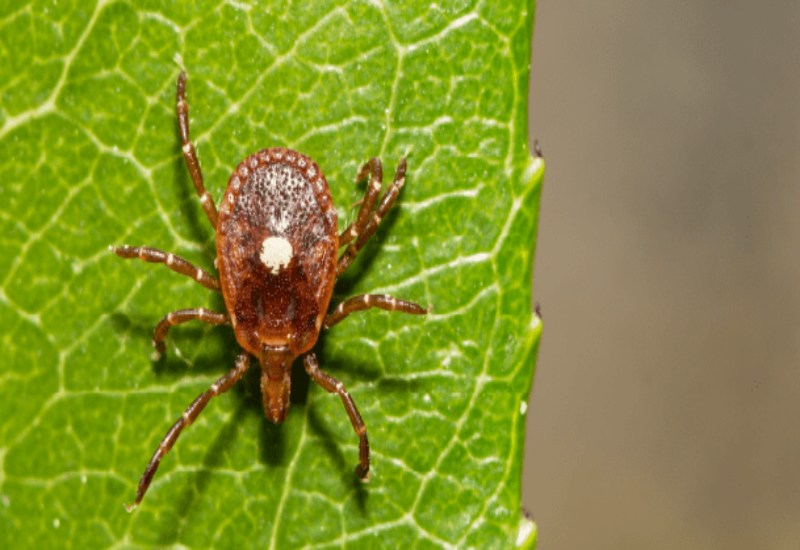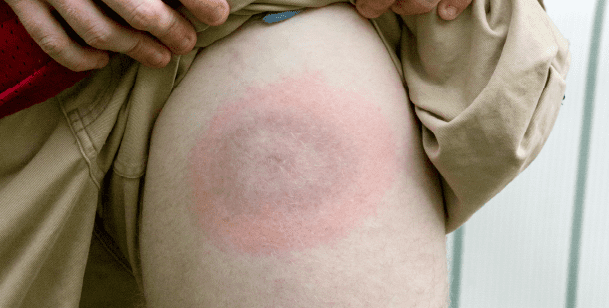Did you know that, according to the CDC, roughly 30,000 cases of Lyme disease are reported each year? Because this infectious disease can sometimes go unrecognized by sufferers, it’s estimated that there are 300,000 cases total in the United States annually.
This illness has many, potentially long-term and dangerous, side effects; very often, Lyme disease and joint pain are thought of as going hand in hand. But, is this true? Can Lyme disease cause joint pain? Keep reading for more information.

What is Lyme Disease?
Put very simply, Lyme disease is a serious infection of the joints, heart, and nervous system. If left untreated, late-stage Lyme disease can cause serious complications and lingering symptoms that can last for several months or, in some cases, years.
Causes of Lyme Disease
Lyme disease occurs when a person is bitten by an infected tick. This is why it is commonly referred to as a “tick-borne disease.” At the start of their life, deer ticks can contract a bacteria called Borrelia burgdorferi after feeding on rodents. As they age and begin to attach to larger hosts, mainly deer, they carry the bacteria in their saliva.
When a person experiences a tick bite, there is a chance that the bacteria from the tick saliva can make its way into the human bloodstream, causing the infection to take hold. Symptoms can begin to appear roughly 30 days after the infected bite.

Symptoms of Lyme Disease
The initial signs of Lyme disease appear as flu-like symptoms. Sufferers may experience the following:
- Fatigue
- Fever
- Headaches
- Chills
- Swollen Lymph Nodes
What will set Lyme disease apart from the common flu are the bullseye-shaped skin rashes called erythema migrans. These marks can appear at the bite site as well as on other parts of the body. This skin rash will appear red and inflamed and will spread outwards in a circular pattern from a central point.

The later stages of Lyme disease, if the illness is left untreated, can cause more serious issues that can last for an extended period of time. Some of these complications include:
- Skin Rashes
- Bell’s Palsy
- Meningitis
- Shooting Pain and Swelling in Joints
- Heart Palpitations
- Memory Loss
- Numbness in Hands or Feet
Does Lyme Disease Cause Severe Joint Pain?
Lyme disease is typically treated with a course of antibiotics. However, studies have shown that as Borrelia burgdorferi is killed, peptidoglycan fragments from the cell walls of the bacteria can break off and survive, settling into a person’s joints and causing persistent pain and swelling for months or years even after the initial bacteria is dead. This condition is known as Lyme arthritis.
Is Lyme Arthritis Curable?
Lyme arthritis is defined as a condition stemming from Lyme disease in which there is recurrent swelling of one or more joints. In most cases, an oral antibiotic treatment is used to address the lingering presence of the harmful bacteria. However, if symptoms persist after 30 days of treatment, intravenous antibiotics may be used to treat the infection.
Symptoms
Some symptoms of Lyme arthritis include the following:
- Joint Pain and Swelling in Knees and Ankles
- Limping
- Swelling and Pain Occurring on One Side of the Body
- Reduced Mobility
- Popping Joints (Crepitus)
If you are experiencing any of these symptoms, it is important that you seek out medical attention as soon as possible to avoid any further, long-lasting complications.
Diagnosis
Once you report your symptoms, either of Lyme disease or Lyme arthritis, to a doctor, blood tests will be used to confirm the presence of illness.
There are two types of tests that will be used in the diagnostic process. The enzyme-linked immunosorbent assay (ELISA) test is used to detect Borrelia burgdorferi-specific antibodies. The ELISA test sometimes produces false positives. Thus, when a positive result occurs, the second test is ordered to confirm the presence of Lyme disease. The second blood test, the Western blot test, is used to detect proteins from Borrelia burgdorferi.
Treatment
Generally, to treat Lyme disease and Lyme arthritis, a round of antibiotics is prescribed. Doxycycline and Amoxicillin are the most commonly used formulas, depending on the age of the person infected.
In more persistent cases, your physician may choose to use intravenous antibiotics, non-steroidal anti-inflammatory drugs, disease-modifying antirheumatic drugs, or intra-articular corticosteroids to address the joint pain you’re experiencing.
If this fails and damage to your joints continues to worsen, your doctor may explore additional treatment options with you, such as steroid injections, physical therapy, or minimally invasive arthroscopic surgery.

Prevention
By and large, the best “treatment” for Lyme disease and Lyme arthritis is prevention! If you can avoid coming into contact with ticks, or properly address their presence right away, your chances of contracting Lyme disease and, by extension, Lyme arthritis are greatly reduced.
To help prevent tick bites, we suggest the following:
- Avoid Overgrown Areas with High Grass and Leaf Litter
- Stay on Walking Trails While in the Woods
- Wear Long Sleeves and Pants
- Use Tick Repellents
- Examine Bodies Thoroughly for Ticks (Ticks gravitate towards the scalp, ears, shoulder blades, waist, belly button, backs of knees, and groin.)
- Shower After Spending Time Outdoors
If you are bit by a tick and find it on your person, do not panic! Ticks can be easily removed, and it is important to do so the correct way.
Remove a latched tick by doing the following:
- Sanitize the bite site and tweezers with soap and water.
- Use tweezers to grasp the tick, getting as close to the skin as possible.
- Pull with steady gentle pressure until the tick is removed.
- Do NOT twist or yank the tick off of yourself; this may cause parts of the tick’s mouth to break off and stay embedded in the skin. This may mean you are still at risk for infection.
- Do NOT apply nail polish or petroleum jelly over the tick in an attempt to suffocate it. This is not an effective method for killing the tick.
- Do NOT try to burn the tick off, as you may cause injury to yourself.
- Once the tick has been removed, clean the bite site well with soap and water, iodine, or rubbing alcohol.
- Continue to monitor yourself for unusual symptoms and seek medical attention immediately if you feel you may have contracted Lyme disease.
Find Relief With a Village Behind You
Now we understand why Lyme disease and joint pain are so closely linked. If you or a loved one have been bitten by a tick and suspect that you may have contracted Lyme disease, or if you feel you may be suffering from Lyme arthritis, reach out to a medical professional for help. Find peace of mind and effective care by working with physicians you can trust. Visit our website for more information.
